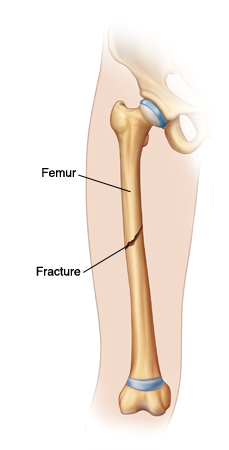When Your Child Has a Femur Fracture
Your child has a break (fracture) in their thighbone (femur). The femur is a strong bone and is very hard to break. So a femur fracture is often the result of great force during severe trauma (such as a car accident, bad fall, or serious sports injury). Your child may have already been seen in an emergency room for initial treatment for the fracture. But more treatment is needed to help the leg heal. A child with a femur fracture is likely to be referred to a surgeon specializing in bone and joint problems (orthopedic surgeon).

Note for parents of young children
Healthcare providers are trained to recognize a femur fracture as a sign of possible child abuse. Several providers may ask questions about how your child was injured. Healthcare providers are required by law to ask you these questions. This is done for your child's protection. Please try to be patient and not take offense.
Types of fractures
A bone can break in many ways. Here are some fracture types you may hear about:
-
Displaced fracture. The broken bone ends don't line up.
-
Nondisplaced fracture. The broken ends are lined up.
-
Open fracture. The bone shows through the skin. These used to be called compound fractures.
-
Closed fracture. There is no break in the skin.
-
Comminuted fracture. The bone is broken into more than two pieces.
What are the symptoms of a femur fracture?
How is a femur fracture diagnosed?
A femur fracture is often diagnosed when the healthcare provider examines the child. An X-ray (test that creates images of bones) will confirm the fracture. Because it takes great force to break the femur, more X-rays may be done to rule out fractures in nearby bones or in bones in other parts of the body.
How is a femur fracture treated?
The goal of treatment for a fracture is to hold bones together so they can heal. The best course of treatment for your child depends on your child’s age, the location of the fracture, and the type and severity of the fracture. Your child’s healthcare provider will explain the choices to you and make recommendations. It generally takes 4 to 12 months for a femur fracture to heal completely.
Spica casting
A spica cast covers the child from waist to ankle. It keeps the thighbone and hip area completely still. This helps the bone heal correctly.
-
A spica cast is left on until the bone is healed, in about 8 to 12 weeks. The child may not be able to walk while the cast is in place.
-
After the cast comes off, the child may need to use crutches for 3 to 4 weeks while the leg regains strength if they are old enough (around age 6). Younger children may need to ride in a stroller or wagon or be carried until they are stronger..
-
This type of cast is mainly used in younger children.
Surgery to place fixation devices
Surgery can be done to place devices that hold the bones together while they heal. These are called fixation devices. This choice lets children get back to school and other aspects of their life (with crutches or a walker) sooner than with casting. During surgery:
Traction, then spica casting
In rare cases, traction may be needed before casting is done. Traction uses a system of ropes, pulleys, and weights attached to metal pins placed into the leg bone. The system gently pulls on the leg bones to help them line up straight.
-
Traction is done in the hospital. It is in place continuously for up to 2 weeks. The child must remain in bed during this time.
-
When traction is complete, the child is put into a spica cast to hold the realigned bone in place while it heals completely.
What are the long-term concerns?
-
After a fracture heals, don’t worry about getting your child to walk right away. Your child will start walking on the leg again when they are ready. Walking too soon can cause more damage to the leg.
-
When your child starts walking again, they may limp or walk awkwardly. This may last for up to a year. But it almost always goes away.
-
After the bone has healed, physical therapy may be advised to help strengthen the leg. Your child’s healthcare provider can tell you more.
-
Just after the fracture heals, the leg may not look straight. But the bone is still going through a process called remodeling. During remodeling, the repaired bone slowly reshapes itself. Most angles or bends in the bone straighten out during this stage. This process takes 1 to 3 years.
-
In some cases, the fractured thighbone may grow faster than the uninjured thighbone in the other leg. This results in a slightly longer leg on the injured side (called a leg-length discrepancy). If this is the case with your child, the provider can discuss it with you.
Online Medical Reviewer:
Dan Brennan MD
Online Medical Reviewer:
Rita Sather RN
Online Medical Reviewer:
Thomas N Joseph MD
Date Last Reviewed:
9/1/2023
© 2000-2024 The StayWell Company, LLC. All rights reserved. This information is not intended as a substitute for professional medical care. Always follow your healthcare professional's instructions.